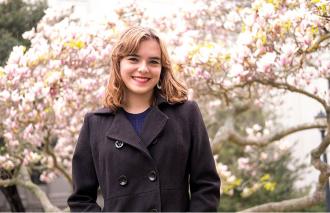For Eleanor Hammond, a freshman at UC Berkeley, a wealthy yet radical woman from 1916 sparked a years long project.
Hammond first encountered her unlikely muse in the summer of 2016 while on a trip to Manhattan’s Whitney Museum of American Art as part of a high school program dedicated to the performing arts, hosted by Sarah Lawrence College. Students were to select a piece of art that inspired a song, scene or dance they would write over the next few weeks. Upon encountering urban realist Robert Henri’s 1916 commissioned portrait of the museum’s namesake, Gertrude Vanderbilt Whitney, Hammond knew her subject matter.
Whitney, a wealthy sculptor, art patron and founder of the Whitney Museum, became Hammond’s obsession over the remainder of that summer. Two years later, and Hammond’s creative work continues to revolve around this influential American sculptor and art patron.
With not only experience in writing and composing music, but also a musical background including singing and playing both guitar and piano, Hammond hopes to bring Whitney’s story to life through musical theater. Her show is tentatively titled “Walls: The Story of Gertrude Vanderbilt Whitney.”
The character of Whitney, as portrayed by Henri, intrigued Hammond largely by virtue of the artist and patron’s unapologetically revolutionary stance in the painting.
“She was kind of addressing the male gaze, in my opinion, and that was very radical because this was in 1916, I believe, and she had pants on. Her husband didn’t allow her to hang it in their home because she was wearing pants,” Hammond said.
The monumental nature of Whitney’s choice of dress in the painting, as well as its ramifications in the patron’s personal life, sparked Hammond’s idea for the first song she wrote for the musical, “Walls.” “Your face, it covers most of the halls. So why can’t I have one place where I can look strong?” she implores in the song’s opening line.
In addition to the visual inspiration of Henri’s portrait, Hammond draws from another form of art to guide her project — the narrative format of B.H. Friedman’s “Gertrude Vanderbilt Whitney: A Biography.” The biography spans Whitney’s life in minute detail, relating the story of an extraordinary life through nearly 700 pages of journal entries, letters and Friedman’s chronicling of this personal history.
Despite the length of the work, however, Hammond described going through the book thoroughly, considering each nook and cranny of Friedman’s work in order to find specific subject matter for her songs. While a whole page or chapter of Whitney’s story may serve as fodder for one of the musical’s tracks, details as minute as a phrase may also spark inspiration. Hammond’s “Goodbye Dearest,” for instance, quotes one of Whitney’s personal letters regarding the infidelities of her husband, Harry Payne Whitney.
“She never sent the letter, and so I picked out some of it, it said ‘Goodbye dearest,’ in the page, and ‘I do not blame you,’ ” Hammond recounted. “With this particular song, the husband was cheating on her many times, and she blamed herself for it, and it was a very interesting relationship. … So it was kind of like being able, for the audience, to hear her voice (even though) her husband never reads the letter,” she said.
Of course, representing Whitney over the course of her life has posed the challenge of relating to a character who has experienced far more life than her 19-year-old musical biographer. Nonetheless, Hammond feels that her own experience with femininity and personal difficulties allows her to comprehend Whitney on a very fundamental level.
“As a woman, and just as me, I’ve overcome some stuff in my life. And so, I feel like my goal is different from hers, but I can get into her shoes because, as a female, I’ve dealt with things that I can understand. … It just doesn’t feel that far off to me,” she said.
Delving into Whitney’s narrative and working to relate to it has not only buoyed Hammond as an artist, but also as an individual. “Gertrude is kind of someone that’s always there for me as a character,” Hammond explained, “Her idea has just been something that’s helped me in my life, that I’m not alone. Reading her biography, it’s every year of her life, and I really feel that I know her even though I don’t.”
In fact, Hammond’s work has not only provided the playwright a sense of community through connecting with Whitney, but given her a tangible community as well. Hammond cited the campus all-female theater company, Golden Women, as a valuable space to workshop “Walls.” She also expressed her gratitude for its provision of a supportive community of women — women who have given her valuable feedback and ideas throughout the musical’s development.
All considered, Hammond described the message of Whitney’s life — and its resonances within Hammond’s own life — as deeply moving and inspiring.
“I’m doing this and, sure, nothing might happen of it, but I’m going to try and believe in myself,” Hammond remarked. “That’s something I struggle with every day, but I want people to know that it’s possible to do anything — and I know it sounds super cheesy, but it’s cool. I don’t know, Gertrude opened a museum in the 1930s, so why can’t you do whatever you want to do?”
Contact Ryan Tuozzolo at rtuozzolo@dailycal.org.
